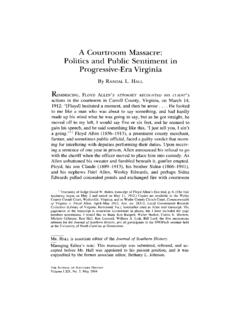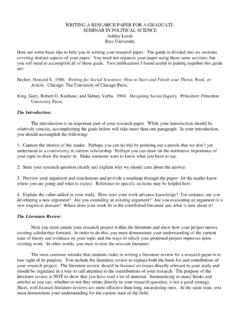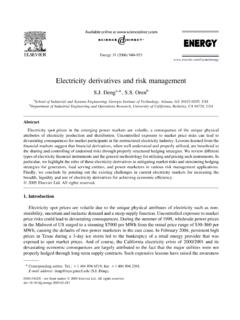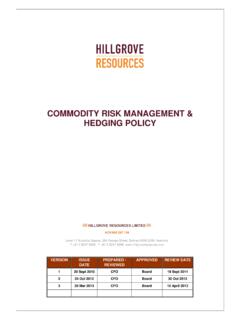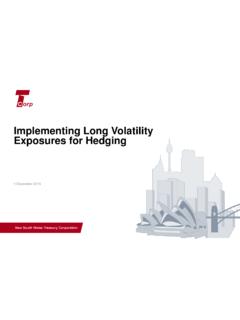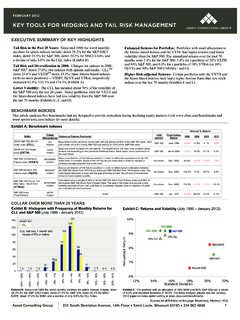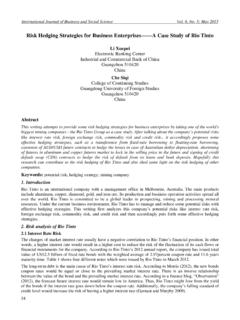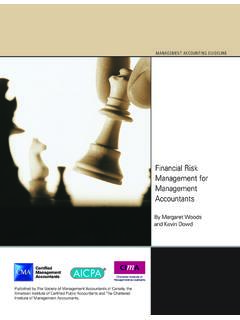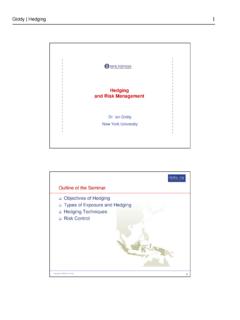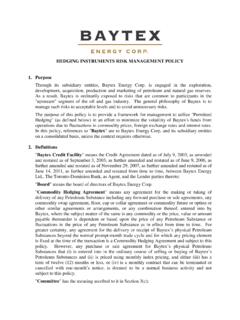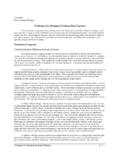Transcription of Exchange-Rate Hedging: Financial versus Operational …
1 Exchange-Rate EXPOSURE OF FIRMS AND WORKERS Exchange-Rate hedging : Financial versus Operational strategies By GEORGE ALLAYANNIS, JANE IHRIG, AND JAMES P. WESTON* Exchange-Rate exposure is an important source of risk for multinational corporations. To mitigate the impact of Exchange-Rate fluctuations, it has been claimed that multinational corporations can employ risk-management strategies not only through Financial derivatives, but also through op- erational hedges. For example, Schering-Plough in its 1995 annual report (p. 25) argues in support of exclusive use of Operational hedges: "To date, management has not deemed it cost-effective to engage in a formula-based program of hedging the profitability of these operations using derivative Financial instruments.
2 Some of the reasons for this conclusion are: The Company operates in a large number of foreign countries; the currencies of these countries generally do not move in the same direction at the same time." Conversely, many corporations with large worldwide networks, such as IBM or Coca Cola, make extensive use of derivative Financial instruments. This paper investigates both Financial and Operational Exchange-Rate risk-management strategies of multinational firms. While several studies have examined either firms' Financial hedging or firms' Operational hedging activities, no study thus far has examined Financial and Operational hedging simultaneously for a large cross section of firms.
3 To the extent that the decision to use Financial hedging strategies is related to (and affected by) the Operational strat- egies that a firm employs, it is important to examine how each strategy contributes to the overall goal of mitigating risk and improving shareholder value. Using a sample of multinational nonfi- nancial firms during 1996-1998, we find that Operational hedging is not an effective substi- tute for Financial risk However, we find that the more geographically dispersed a firm is, the more likely it is to use Financial hedges. The end result on firm value is that Operational hedging strategies benefit share- holders only when used in combination with Financial hedging strategies .
4 I. The Use of Financial and Operational hedging strategies In this study we use four proxies for a firm's Operational hedging : (i) the number of countries in which it operates, (ii) the number of broad regions in which it is located,2 (iii) the geo- graphic dispersion of its subsidiaries across countries, and (iv) the geographic dispersion of its subsidiaries across regions. Most of these measures of Operational hedging strategies are * Allayannis: Darden Graduate School of Business Administration, University of Virginia, Box 6550, Charlottesville, VA 22906; Ihrig: Division of Interna- tional Finance, Federal Reserve Board, 20th and C Streets , Washington, DC 20551; Weston: Jesse H.
5 Jones Graduate School of Management, Rice University, Houston, TX 77005. We thank Cynthia Petruska and Sadayuki Ono for invaluable research assistance. The views in this paper are solely the responsibilities of the authors and should not be interpreted as reflecting the views of the Board of Governors of the Federal Reserve System or of other members of its staff. 1 Our data set consists of all COMPUSTAT companies for which there exists level-I subsidiary data from the National Registry. The final sample consists of 265 firms over three years for a total of 795 firm-year observations.
6 Balance-sheet and income statement information is from COMPUSTAT. Return data are collected from the Center for Research in Security Prices (CRSP). The foreign- currency-derivatives data are collected from the footnotes of the annual reports for each firm-year. Data are avail- able from the authors upon request. 2 We divide the world into ten major regions: NAFTA (North American Free Trade Agreement), Europe, remain- ing Western Europe, advanced Asia, other Asian, Eastern Europe, Central and South America, Africa, Middle East, and Southeast Asia. 391 This content downloaded on Mon, 28 Jan 2013 13:49:56 PMAll use subject to JSTOR Terms and Conditions392 AEA PAPERS AND PROCEEDINGS MAY 2001 significantly positively correlated.
7 For example, the correlation between the country dispersion index and the number of countries (regions) is ( ). Geographic dispersion is constructed with the Hirschman-Herfindahl concentration index over all the countries or regions in which a firm operates. For example, our third measure of geographic dispersion for firm i is calculated as: (1) (Dispersion)i i [ (No. subsidiaries)j 12 1 (Total no. subsidiaries)iJ j= I where K is the total number of countries in which firm i operates. This measure has a value close to 1 if the firm has subsidiaries in many countries and a value of 0 if the firm has sub- sidiaries in only one country.]
8 We begin by examining whether the use of Operational hedges affects the Exchange-Rate risk of corporations. We create a measure of Exchange-Rate exposure for each firm using a two-factor model as in Philippe Jorion (1990). In this model, the dependent variable is the rate of return on each firm's stock, and the two factors are the rate of return on the market portfolio and an Exchange-Rate index. We esti- mate a firm's exposure, for each firm-year, by estimating the coefficient on a monthly firm- specific Exchange-Rate index using monthly re- turn data during the three years surrounding the particular Exchange-Rate exposure is then regressed on the use of Financial and operating hedges as well as on the percentage of overall reve- nues from abroad.
9 The Financial -hedge vari- able is an indicator variable set equal to 1 if the firm has foreign-currency derivatives or uses foreign If firms use currency deriv- TABLE 1-GEOGRAPHICAL DISPERSION AND EXCHANGE- RATE EXPOSURE (DEPENDENT VARIABLE: Exchange-Rate EXPOSURE > 0) Independent variable (i) (ii) (iii) (iv) Financial hedge * * * * Dummy ( ) ( ) ( ) ( ) Foreign/total sales ( ) ( ) ( ) ( ) Dispersion index - - - (all countries) ( ) Dispersion index - - (all regions) ( ) ln(no. countries) - - - ( ) ln(no. regions) - - - ( ) R2: No.
10 Observations: 508 508 508 508 Note: Standard errors are reported (in parentheses) below coefficient estimates. Statistically significant at the 10-percent level. * Statistically significant at the 5-percent level. atives or foreign debt as a hedge, then we should expect a negative relationship between the use of Financial hedges and Exchange-Rate risk. Similarly, if firms use geographic disper- sion as a means to hedge Exchange-Rate risk, then we should expect a negative relationship. Ceteris paribus, the higher the percentage of revenues that are generated abroad, the higher is the Table 1 presents the results of ordinary least-squares (OLS) regressions using all firm-years (1996-1998), but similar results are obtained in tests by year.



